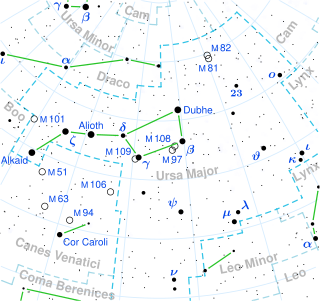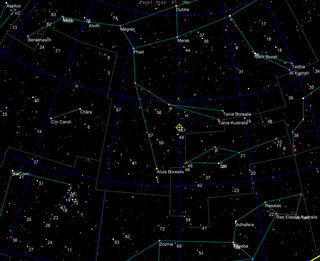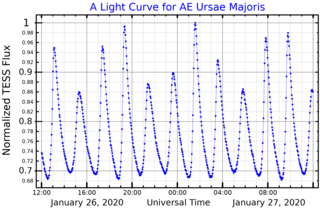
Alioth, also called Epsilon Ursae Majoris, is a star in the northern constellation of Ursa Major. The designation is Latinised from ε Ursae Majoris and abbreviated Epsilon UMa or ε UMa. Despite being designated "ε" (epsilon), it is the brightest star in the constellation and at magnitude 1.77 is the thirty-third brightest star in the sky.

Ursa Major is a constellation in the northern sky, whose associated mythology likely dates back into prehistory. Its Latin name means "greater bear", referring to and contrasting it with nearby Ursa Minor, the lesser bear. In antiquity, it was one of the original 48 constellations listed by Ptolemy in the 2nd century AD, drawing on earlier works by Greek, Egyptian, Babylonian, and Assyrian astronomers. Today it is the third largest of the 88 modern constellations.

Phecda, also called Gamma Ursae Majoris, is a star in the constellation of Ursa Major. Since 1943, the spectrum of this star has served as one of the stable anchor points by which other stars are classified. Based upon parallax measurements with the Hipparcos astrometry satellite, it is located at distance of around 83.2 light-years from the Sun.

Merak, also called Beta Ursae Majoris, is a star in the northern constellation of Ursa Major.

47 Ursae Majoris, formally named Chalawan, is a yellow dwarf star approximately 45.3 light-years from Earth in the constellation of Ursa Major. As of 2011, three extrasolar planets are believed to orbit the star.

70 Virginis b is an extrasolar planet approximately 60 light-years away in the constellation of Virgo. Announced in 1996 by Geoffrey Marcy and R. Paul Butler, 70 Virginis was one of the first stars confirmed to have planets orbiting it. When first announced, 70 Virginis b was considered to be within its star's habitable zone, but it was later confirmed that the planet has an eccentric orbit, closer to its parent.
Iota Ursae Majoris, also named Talitha, is a star system in the northern circumpolar constellation of Ursa Major. It has an apparent visual magnitude of 3.14, making it visible to the naked eye and placing it among the brighter members of this constellation. Based upon parallax measurements, it is located at a distance of 47.3 light-years from the Sun.
Theta Ursae Majoris is a suspected spectroscopic binary star system in the northern circumpolar constellation of Ursa Major. It has an apparent visual magnitude of 3.17, placing it among the brighter members of this constellation. The distance to this star has been measured directly using the parallax method, yielding an estimated value of 43.96 light-years.
Omicron Ursae Majoris, formally named Muscida, is a star system in the northern circumpolar constellation of Ursa Major. It has an apparent visual magnitude of +3.35 and is located at a distance of around 179 light-years from the Sun. In 2012, an exoplanet designated Omicron Ursae Majoris Ab was found to be orbiting the primary.
Kappa Ursae Majoris is a binary star in the constellation of Ursa Major. With a combined apparent magnitude of +3.60, the system is approximately 358 light-years from Earth.
4 Ursae Majoris (sometimes abbreviated 4 UMa) is the Flamsteed designation of a star in the northern circumpolar constellation of Ursa Major. It also bears the Bayer designation of Pi2 Ursae Majoris (Pi2 UMa, π2 Ursae Majoris, π2 UMa) and is traditionally named Muscida. With an apparent visual magnitude of +4.6, this star is visible from suburban or darker skies based upon the Bortle Dark-Sky Scale. From parallax measurements made during the Hipparcos mission, this star is at a distance of 256 light-years (78 parsecs) from Earth. As of 2011, one extrasolar planet has been confirmed to be orbiting the star.

47 Ursae Majoris b, formally named Taphao Thong, is a gas planet and an extrasolar planet approximately 46 light-years from Earth in the constellation of Ursa Major. The planet was discovered located in a long-period orbit around the star 47 Ursae Majoris in January 1996 and as of 2011 it is the innermost of three known planets in its planetary system. It has a mass at least 2.53 times that of Jupiter.

47 Ursae Majoris c, formally named Taphao Kaew is an extrasolar planet approximately 46 light-years from Earth in the constellation of Ursa Major. The planet was discovered located in a long-period around the star 47 Ursae Majoris. Its orbit lasts 6.55 years and the planet has a mass at least 0.540 times that of Jupiter.

Doppler spectroscopy is an indirect method for finding extrasolar planets and brown dwarfs from radial-velocity measurements via observation of Doppler shifts in the spectrum of the planet's parent star. As of November 2022, about 19.5% of known extrasolar planets have been discovered using Doppler spectroscopy.

TX Ursae Majoris is an eclipsing binary star system in the northern circumpolar constellation of Ursa Major. With a combined apparent visual magnitude of 6.97, the system is too faint to be readily viewed with the naked eye. The pair orbit each other with a period of 3.063 days in a circular orbit, with their orbital plane aligned close to the line of sight from the Earth. During the primary eclipse, the net brightness decreases by 1.74 magnitudes, while the secondary eclipse results in a drop of just 0.07 magnitude. TX UMa is located at a distance of approximately 780 light years from the Sun based on parallax measurements, but is drifting closer with a mean radial velocity of −13 km/s.

XY Ursae Majoris is a short period binary star system in the northern circumpolar constellation of Ursa Major. It is an eclipsing binary with a baseline apparent visual magnitude of 9.50. The system is located at a distance of 221.5 light years from the Sun based on parallax measurements, but is drifting closer with a radial velocity of −10 km/s. It has a relatively high proper motion, traversing the celestial sphere at the angular rate of 0.191″·yr−1.

SW Ursae Majoris is a cataclysmic binary star system in the northern circumpolar constellation of Ursa Major, abbreviated SW UMa. During quiescence it has an apparent visual magnitude of 16.5–17, which is too faint to be visible to the naked eye. Based on parallax measurements, it is located at a distance of approximately 526 light years from the Sun.

AE Ursae Majoris is a star in the northern circumpolar constellation of Ursa Major, abbreviated AE UMa. It is a variable star that ranges in brightness from a peak apparent visual magnitude of 10.86 down to 11.52. The distance to this star is approximately 2,400 light years based on parallax measurements.

ER Ursae Majoris is a variable star in the northern circumpolar constellation of Ursa Major, abbreviated ER UMa. It is a prototype system for a subclass of SU Ursae Majoris dwarf novae. The system ranges in brightness from a peak apparent visual magnitude of 12.4 down to 15.2, which is too faint to be visible to the naked eye. The distance to this system, based on parallax measurements, is approximately 1,163 light years.













